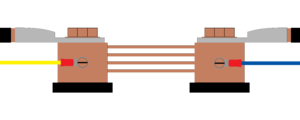Shunt
A shunt is a device that is put in series in a circuit that enables current flow to be measured. A shunt will have a very low defined resistance that creates a small amount of voltage drop from one side of the shunt to the other, which can be used to determine the amount of current that is flowing. It can be difficult to get an accurate measurement of the state of charge (SOC) of a battery bank just using voltage. A shunt is very useful in an off-grid PV system as it permits a charge controller to estimate the state of charge of a battery bank more accurately. The calculated state of charge is typically available to users via a battery or monitoring system to enable them to adjust their power consumption accordingly. In larger systems in which charge controllers, inverters, and generators are integrated, the information can also be used to control how the inverter and generator function. The most commonly used type of shunt is rated to up to 500 A and has a resistance of .0001 Ω (ohms) or 100 µΩ (microohms). This configuration will produce a voltage drop of 1 mV per 10 A of current.
The calculation that is performed to determine the amount of current flowing in a circuit uses Ohm's Law:
| Voltage (V) | = current (I) × resistance (R) |
|---|
If two variables for a circuit are known, the third can be calculated using Ohm's Law. In the case of a shunt, resistance and voltage are known variables. The formula can be rearranged to solve for current.
| Current (I) | = voltage (V) ÷ resistance (R) |
|---|
Example 1: A 12 V DC circuit has a voltage of 12.5V and it is passing through a shunt with a .0001 Ω rated resistance. The voltage reading on the other side of the shunt is 12.497 V. How much current is flowing in the circuit?
Voltage drop in shunt = 12.5 V - 12.497 V = .003 V
- I = .003 V ÷ .0001 Ω
- I = 30 A
